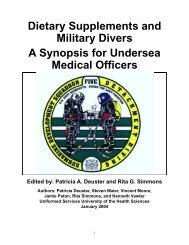Force Health Protection: Nutrition and Exercise Resource Manual
Force Health Protection: Nutrition and Exercise Resource Manual
Force Health Protection: Nutrition and Exercise Resource Manual
Create successful ePaper yourself
Turn your PDF publications into a flip-book with our unique Google optimized e-Paper software.
Note: Do not perform maximal lifts when strength training.<br />
Type of <strong>Exercise</strong><br />
Muscle balance refers to the strength ratio of opposing muscle groups<br />
across a common joint; i.e., the biceps <strong>and</strong> triceps muscles in the upper arm.<br />
By performing exercises that target the opposing muscle groups across the<br />
joints, you improve the function of the joints <strong>and</strong> reduce your risks for injury.<br />
With this in mind, select at least one exercise for each of the major muscle<br />
groups. The major muscle groups are the chest, back, shoulders, arms, legs,<br />
lower back, <strong>and</strong> abdominals. (See Worksheet B-2.)<br />
Biceps (inactive)<br />
Biceps (active)<br />
Triceps<br />
(active)<br />
Triceps<br />
(inactive)<br />
From Harmon, E. The biomechanics of resistance exercise. In Essentials of Strength Training <strong>and</strong><br />
Conditioning. Baechle, TR. (Ed.). Human Kinetics. Champaign, Il. 1994. p.20.<br />
With respect to exercise order, perform multi-joint<br />
exercises (e.g., squats) before single-joint exercises (e.g.,<br />
leg curl). To determine which exercises are multi- versus<br />
single joint exercises, watch <strong>and</strong> feel how many joints<br />
move while you perform the exercise. An example of a<br />
multi-joint exercise is the bench press because your<br />
upper <strong>and</strong> lower arms move at the shoulder <strong>and</strong> elbow<br />
Bench Press Arm Curl<br />
joints, respectively. An example of a single-joint exercise is a biceps curl<br />
because only your lower arm moves at the elbow. Single-joint exercises target<br />
<strong>and</strong> fatigue the smaller muscle groups that are needed to perform multi-joint<br />
exercises. Therefore, fatiguing the smaller muscle groups by first performing<br />
single-joint exercises will alter your lifting form <strong>and</strong> decrease the amount of<br />
weight you can lift in the multi-joint exercises. Lastly, lower back <strong>and</strong><br />
abdominal exercises should be performed at the end of your workout because<br />
these muscles are used during other exercises for balance <strong>and</strong> posture.<br />
Figure 7-2 is a diagram of the muscle groups <strong>and</strong> the exercises that target<br />
them. Pick at least one exercise per major muscle group.<br />
<strong>Nutrition</strong> <strong>and</strong> <strong>Exercise</strong> <strong>Resource</strong> <strong>Manual</strong> 61




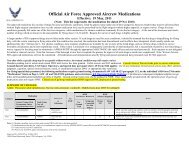
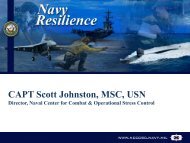
![Body Composition and Military [PDF] - Human Performance ...](https://img.yumpu.com/43269347/1/190x245/body-composition-and-military-pdf-human-performance-.jpg?quality=85)
![Tips for Grocery Shopping [PDF]](https://img.yumpu.com/37447379/1/190x245/tips-for-grocery-shopping-pdf.jpg?quality=85)
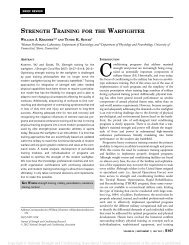
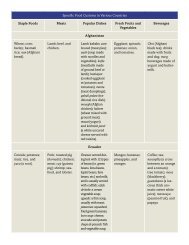
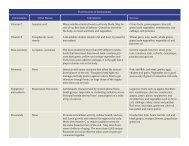
![Synthetic Drugs [PDF] - Human Performance Resource Center](https://img.yumpu.com/37447322/1/190x245/synthetic-drugs-pdf-human-performance-resource-center.jpg?quality=85)
